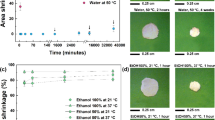Abstract
The purpose of this study is to determine whether sodium alginate solutions’ rheological parameters are meaningful relative to sodium alginate’s use in the formulation of calcium alginate gels. Calcium alginate gels were prepared from six different grades of sodium alginate (FMC Biopolymer), one of which was available in ten batches. Cylindrical gel samples were prepared from each of the gels and subjected to compression to fracture on an Instron Universal Testing Machine, equipped with a 1-kN load cell, at a cross-head speed of 120 mm/min. Among the grades with similar % G, (grades 1, 3, and 4), there is a significant correlation between deformation work (L E) and apparent viscosity (η app). However, the results for the partial correlation analysis for all six grades of sodium alginate show that L E is significantly correlated with % G, but not with the rheological properties of the sodium alginate solutions. Studies of the ten batches of one grade of sodium alginate show that η app of their solutions did not correlate with L E while tan δ was significantly, but minimally, correlated to L E. These results suggest that other factors—polydispersity and the randomness of guluronic acid sequencing—are likely to influence the mechanical properties of the resultant gels. In summary, the rheological properties of solutions for different grades of sodium alginate are not indicative of the resultant gel properties. Inter-batch differences in the rheological behavior for one specific grade of sodium alginate were insufficient to predict the corresponding calcium alginate gel’s mechanical properties.







Similar content being viewed by others
Notes
The number of moles of sodium alginate monomers (n monomer) can be calculated as m alginate/(198 g/mole).
REFERENCES
McHugh DJ. Production, properties and uses of alginates. In: McHugh DJ, editor. Production and utilization of products from commercial seaweeds. Rome: Food & Agriculture Organization of the United Nations (FAO); 1988. p. 43–91.
Skjaak-Braek G, Martinsen A. Application of some algal polysaccharides in biotechnology. In: Guiry MD, Blunden G, editors. Seaweed resources in Europe: uses and potentials. New York: Wiley; 1991. p. 219–57.
Wells LA, Sheardown H. Extended release of high pI proteins from alginate microspheres via a novel encapsulation technique. Eur J Pharm Biopharm. 2007;65:329–35.
Rubio MR, Ghaly ES. In-vitro release of acetaminophen from sodium alginate controlled release pellets. Drug Dev Ind Pharm. 1994;20:1239–51.
Thomas S. Alginate dressings in surgery and wound management—part 1. J Wound Care. 2000;9:56–60.
King S, See H, Thomas G, Swain M. Determining the complex modulus of alginate irreversible hydrocolloid dental material. Dent Mater. 2008;24:1545–8.
Grant GT, Morris ER, Rees DA, Smith PJC, Thom D. Biological interactions between polysaccharides and divalent cations: the egg-box model. FEBS Lett. 1973;32:195–8.
Morris ER, Rees DA, Thom D, Boyd J. Chiroptical and stoichiometric evidence of a specific, primary dimerisation process in alginate gelation. Carbohydr Res. 1978;66:145–54.
Fang Y, Al-Assaf S, Phillips GO, Nishinari K, Funami T, Williams PA, et al. Multiple steps and critical behaviors of the binding of calcium to alginate. J Phys Chem B. 2007;111:2456–62.
Haug A, Myklestad S, Larsen B, Smidsrod O. Correlation between chemical structure and physical properties of alginates. Acta Chem Scand. 1967;21:768–78.
Penman A, Sanderson GR. A method for the determination of uronic acid sequence in alginates. Carbohydr Res. 1972;25:273–82.
Draget KI, Simensen MK, Onsoyen E, Smidsrod O. Gel strength of Ca-limited alginate gels made in situ. Hydrobiologia. 1993;260/261:563–9.
Smidsrod O, Haug A. Properties of poly (1, 4-hexauronates) in gel state. II. Comparison of gels of different chemical composition. Acta Chem Scand. 1972;26:79–88.
Mancini M, Moresi M, Rancini R. Mechanical properties of alginate gels: empirical characterisation. J Food Eng. 1999;39:369–78.
Kakita H, Kamishima H. Some properties of alginate gels derived from algal sodium alginate. J Appl Phycol. 2008;20:543–9.
Mancini M, Moresi M, Rancini R. Uniaxial compression and stress relaxation tests on alginate gels. J Texture Stud. 1999;30:639–57.
Peleg M, Campanella OH. The mechanical sensitivity of soft compressible testing machines. J Rheol. 1989;33:455–67.
Peleg M. Review: Mechanical properties of dry cellular solid foods. Food Sci Technol Int. 1997;3:227–40.
Draget KI, Strand B, Hartmann M, Valla S, Smidsrod O, Skjak-Braek G. Ionic and acid gel formation of epimerized alginates; the effect of AlgE4. Int J Biol Macromol. 2000;27:117–22.
Grasdalen H, Larsen B, Smidsrød O. A p.m.r. study of the composition and sequence of uronate residues in alginates. Carbohydr Res. 1979;68:23–31.
Grasdalen H. 1H-n.m.r. spectroscopy of alginate: sequential structure and linkage conformations. Carbohydr Res. 1983;118:255–60.
Larsen B. Biosynthesis of alginate. Proc Int Seaweed Symp. 1981;10:7–34.
Stokke BT, Smidsrod O, Bruhelm P, Skjaak-Braek G. Distribution of uronate residues in alginate chains in relation to alginate gelling properties. Macromolecules. 1991;24:4637–46.
Stokke BT, Smidsrod O, Zanetti F, Strand B, Skjaak-Braek G. Distribution of uronate residues in alginate chains in relation to alginate gelling properties—2: enrichment of β-d-mannuronic acid and depletion of α-l-guluronic acid in sol fraction. Carbohydr Polym. 1993;21:39–46.
Skják-Bræk G, Smidsrød O, Larsen B. Tailoring of alginates by enzymatic modification in vitro. Int J Biol Macromol. 1986;8:330–6.
ACKNOWLEDGMENTS
The authors thank Dr. Brian Carlin (FMC Biopolymer, Princeton, NJ) for providing the various grades and batches of sodium alginate used in this study.
Author information
Authors and Affiliations
Corresponding author
Additional information
Guest Editors: Otilia Koo, Thomas Farrell, Allison Radwick, and Sameer Late
Rights and permissions
About this article
Cite this article
Fu, S., Thacker, A., Sperger, D.M. et al. Relevance of Rheological Properties of Sodium Alginate in Solution to Calcium Alginate Gel Properties. AAPS PharmSciTech 12, 453–460 (2011). https://doi.org/10.1208/s12249-011-9587-0
Received:
Accepted:
Published:
Issue Date:
DOI: https://doi.org/10.1208/s12249-011-9587-0




